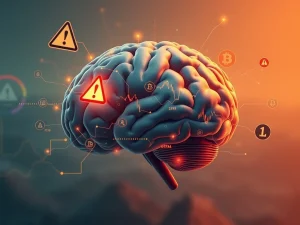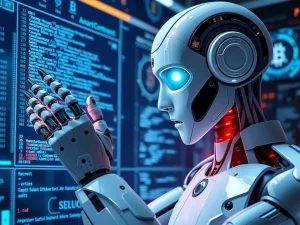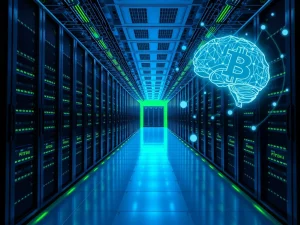AI in Education: Teachers Triumphantly Navigate New Learning Frontiers

The academic year is in full swing, and educators globally face a profound shift. The rise of sophisticated AI tools, particularly large language models like ChatGPT, presents both unprecedented opportunities and significant challenges within the classroom. For those in the crypto space, understanding technological evolution is paramount. Just as blockchain reshapes finance, AI is fundamentally altering AI in education. This article delves into how teachers are not just confronting but actively embracing and transforming their methods to ensure students thrive in this new era of digital intelligence. The landscape of learning is changing rapidly, demanding innovative approaches from all involved.
Educators Embrace AI Tools for Enhanced Learning
Since ChatGPT’s debut, students have found new ways to complete assignments. However, forward-thinking educators view AI as an indispensable resource. John von Seggern, founder of the Futureproof Music School, highlights AI tutors’ potential. He notes they offer “true personalization at scale.” This creates a unique one-on-one educational experience for every student. Furthermore, AI allows students to delegate routine research tasks. They can then focus on core learning objectives. This frees up valuable time for deeper engagement. Some educators also believe AI helps students acquire supplementary skills more quickly. Therefore, integrating these AI tools thoughtfully can enrich the learning process.
The conversation around AI in education often sparks debate. Critics worry about potential misuse. Yet, proponents see immense benefits. The ability of AI to provide instant feedback and tailored content is revolutionary. It moves beyond traditional teaching models. This adaptation is crucial for preparing students for a tech-driven future. Teachers are learning to guide students in using AI responsibly. They emphasize critical evaluation of AI-generated content. This balance ensures technology serves learning, not shortcuts. The pedagogical landscape is evolving rapidly, demanding continuous innovation from educators.
Addressing the AI Challenges in Academia
AI’s reputation in education faces scrutiny, and for valid reasons. Reports have indicated a notable decline in AI token usage among students at the close of recent school years. Here, ‘AI tokens’ referred to students leveraging ChatGPT for their studies. This trend raised alarms among educators. Many expressed exasperation at AI’s growing presence. Daniel Myers, an associate professor of computer science at Rollins College, explains a core issue. He states, “The biggest challenge of AI is that it breaks the connection between the work that students submit and the learning behind that work.” In the past, correct citations in a paper implied learning. Now, AI complicates this assumption. We cannot draw direct conclusions about learning from submitted work alone. This presents significant AI challenges for assessment.
Myers emphasizes the importance of ‘friction’ in learning. Learning requires difficulty and appropriate challenge. Undisciplined AI use removes this vital educational experience. It allows students to bypass genuine effort. Consequently, educators are developing new methods. They are changing approaches to ensure students engage with the material. Von Seggern’s institution requires students to submit entire projects. This allows instructors to observe the entire workflow. “We’re fine with students using AI in their workflows, but we need to see their process,” he explains. This approach helps students develop essential skills. It also mitigates cheating concerns. Moreover, it ensures true understanding of the subject matter. This proactive stance is vital for maintaining academic integrity.
How Teachers Adapt AI Integration for Deeper Understanding
The shift in teaching methodologies is profound. Educators must “lean into designing and curating the educational experience,” Myers advises. This includes re-evaluating class goals in light of AI. Computer science, in particular, has seen a massive impact. AI is now proficient enough at coding to “completely obliterate” past assignments. Myers has moved much of the students’ core programming practice into the classroom. This ensures in-person observation and interaction. Out-of-class assignments are now larger and more creative. They also include guidance on using AI effectively for design. “When designing an assignment, I now think a lot about agency,” Myers notes. He challenges students to set visions and pursue them. This fosters ownership over their work. When students feel agency, they become dissatisfied with low-quality AI generations. Thus, teachers adapt AI use to foster critical thinking.
This evolving pedagogical approach prioritizes student engagement. It focuses on processes over just outcomes. Teachers are becoming facilitators of AI-assisted discovery. They guide students to leverage AI as a research assistant. They also teach students to critically evaluate AI outputs. This ensures students develop strong analytical skills. The goal is not to ban AI but to integrate it wisely. This prepares students for a world where AI will be ubiquitous. Furthermore, it helps them develop the discernment needed to navigate complex information landscapes. These strategies are essential for effective learning in the digital age.
Unlocking the Future of Learning with AI
Despite its challenges, AI offers immense opportunities to “supercharge” education. Myers believes it allows students to access a vast range of knowledge. It also provides skills and perspectives that were previously difficult to obtain. He observes students effectively using AI for ambitious projects. These projects often include a personal creative element. “We often say that AI is ‘like having a minor in everything,'” he remarks. Von Seggern adds that AI offloads tedious parts of music production. This allows students more time for listening, decision-making, and finishing work. Moreover, AI tutors, when implemented correctly, can provide personalized attention. They replicate the benefits of a one-on-one teacher-student relationship. “An AI assistant can give every student a 24/7 personal learning coach,” he explains. This coach adapts to individual backgrounds, goals, and pace. It also shortens the feedback loop from days to seconds, accelerating learning. This is the promising future of learning.
AI developers are actively creating models specifically for education. University administrators show growing interest in these possibilities. Anthropic, for instance, developed Claude for Education. This model builds on its core Claude AI. It includes specialized features for academic use. A spokesperson for Anthropic highlights its Learning Mode. This feature focuses on critical thinking through guided exploration. It avoids direct answers. Instead, it walks students through methodologies. It helps them understand concepts involved in a calculus problem, for example. In July 2025, Anthropic established a Higher Education Advisory Board. Chaired by Rick Levin, former Yale president, this board includes members from leading universities. It ensures AI development aligns with educational values. It also adheres to pedagogical best practices. Anthropic also partners with universities. These collaborations help understand and address implementation challenges in real educational settings. This commitment to educational values is crucial.
Navigating AI’s Impact on Critical Thinking Skills
Even with specialized models, the potential for misuse and overdependence remains. Anthropic’s research from August revealed a concern. Nearly half (47%) of student-AI conversations involve direct answer-seeking. This occurs with minimal engagement. This raises questions about critical thinking development. It suggests a potential overreliance on AI. Anthropic commits to analyzing usage patterns. They plan to share both positive findings and areas of concern. This transparency is vital. It ensures responsible development of AI tools for students and teachers. The goal is to enhance, not diminish, critical thinking skills. Therefore, the ongoing dialogue between educators and developers is paramount.
AI is undeniably here to stay in education. Educators are developing novel strategies. They address the technology’s challenges. They also strive to improve student education. This process will involve growing pains. It requires active participation from educators, developers, and students. This collaborative effort will ensure that education remains robust and effective. The integration of AI must support, not undermine, the core principles of learning. It is a journey of continuous adaptation and innovation. The ultimate goal is to empower students. They must be ready for a complex, AI-driven world. The careful navigation of these advancements will shape the next generation of learners. It will define how we approach knowledge acquisition. This is a crucial undertaking for society’s progress.
Magazine: ChatGPT’s links to murder, suicide and ‘accidental jailbreaks’: AI Eye








